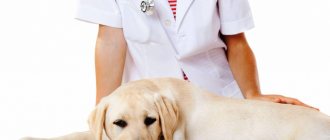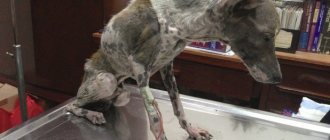Adenovirus infection
A respiratory disease in dogs (most often it is type 2 of the virus) affects the upper respiratory tract, causing inflammation and swelling of the nasal and pharyngeal mucosa.
Infectious hepatitis is caused by adenovirus type 1.
After infection, the animal develops diarrhea, vomiting, and the temperature rises to +40 °C . Puppies are more susceptible to infection; adult dogs get sick less often.
Characteristic symptoms
The manifestation of the disease depends on what type of virus has entered the dog’s body.
Type 1 virus
Symptomatically, adenovirus type 1 (infectious hepatitis) gives the following symptoms:
- refusal of food;
- apathy and lethargy;
- strong thirst;
- temperature rises to 40C (at normal 38.5C);
- diarrhea and vomiting;
- urine is dark with a pungent odor.
The addition of a secondary infection provokes the development of uevitis, the cornea of the eye becomes cloudy, and photophobia appears.
Infectious hepatitis manifests itself in three forms:
- Super acute. Damage occurs to the circulatory and central nervous systems. There are signs of bleeding disorders, a feverish state is observed, which indicates an increase in temperature. Type 1 adenovirus is especially dangerous in puppies, which can die within a few hours. That is why veterinarians constantly remind you of the need to bring your pet to the veterinary clinic at the slightest ailment. The main thing is to react in time to diseases with a high probability of death.
- Spicy. A typical sign of this form is a febrile state of the dog with a complete lack of appetite, vomiting, and diarrhea. During the examination, the doctor will note an enlargement of the lymph nodes and liver, ascites is developing (abdominal edema, exudate or transudate in the abdomen as a consequence of cirrhosis of the liver). The inflammatory process spreads to the membranes of the brain, which causes death.
- Subacute. In this case, grade 1 adenovirus passes through periods of exacerbation of the disease, the manifestation of characteristic symptoms and periods of remission when symptoms do not appear.
- Chronic. Against the background of the dog’s apparent well-being, loss of appetite, cases of fever, malaise, and gastrointestinal disorders in combination with eye damage are periodically noted.
With strong immunity, adenovirus occurs in a mild form, but this does not mean that it does not need to be treated. There is no liver damage, but there are significant problems with the eyes - the risk of developing corneal ulcers and glaucoma. The dog is a carrier of the adenovirus, so contact with other animals must be avoided.
For pregnant bitches, infectious hepatitis is especially dangerous; it leads to fetal death and miscarriage. If such a symptom occurs, the animal is immediately taken to a veterinary clinic; without treatment, the dog will die.
Virus type 2
More gentle than infectious hepatitis. CAV2 is rarely fatal. The disease affects the respiratory tract and lungs. The most important symptom of this type of adenovirus is a severe and dry cough.
Another name for such an adenovirus is infectious tracheobronchitis, “kennel cough”, respiratory tract adenovirus.
CAV2 causes the following symptoms:
- Severe cough, up to attacks of vomiting.
- During physical activity and long runs, the cough intensifies.
- Lethargy of the pet, apathy.
- The lymph nodes in the neck are enlarged.
- There are serous (transparent) discharges from the eyes and nose.
- When listening to the lungs, wheezing is heard and breathing is difficult.
Adenovirus affects weakened animals, puppies under 1.5 months of age, and dogs without vaccination. Almost always, animals that were kept at home until a certain age and then ended up in nurseries or shelters have a chance of catching adenovirus.
The incubation period is up to 30 days, but the weaker the dog, the sooner symptoms will appear. The risk of illness increases significantly with congenital problems with the respiratory system. If there is no therapy for CAV2, pneumonia develops, and here the prognosis is more unfavorable than good.
The first 5 days of illness are considered the most difficult; with proper care and treatment, recovery occurs. If after this period there is no positive dynamics, we can talk about complications and the need for urgent radiography.
Cough can be caused by:
- heart failure;
- pneumonia;
- helminthiasis;
- a foreign object that injures the pharynx.
The main problem with the spread of adenovirus and its complications is irresponsible owners who consider coughing a non-serious symptom.
You should not compare a “human cough” during a cold with a cough in animals; it may indicate more serious problems than an adenovirus.
Consequences of infection
With type 2 infection (adenovirosis), the nasopharynx, eye mucosa, lungs, and lymph nodes are affected. After infection, the pet develops shortness of breath, coughing, accompanied by vomiting and belching. Wheezing appears in the lungs, and the lymph nodes become enlarged. Body temperature does not increase.
Type 1 adenovirus affects the dog’s liver and digestive tract. This disease is also called viral hepatitis.
Consequences of infection: vomiting, diarrhea, hemorrhages, pain in the abdominal wall. Often with infectious hepatitis, clouding of the cornea of the eye can be observed, and keratitis is diagnosed.
Two types of disease
Symptoms and treatment of adenovirus infection in dogs depend on the type. The most dangerous is CAV-1, or type 1 virus.
Type 1
CAV-1 causes infectious hepatitis. It affects the liver and other important organs of the digestive tract. The virus destroys white blood cells and moves freely in the body through the bloodstream. If the form of the disease turns out to be mild, then vision is affected. The animal develops corneal ulcers and develops glaucoma, which can lead to vision loss.
Type 2
CAV-2 causes adenovirus, or “kennel cough.” It affects the nasopharynx, mucous membranes of the eyes and lungs. There are far fewer deaths associated with CAV-2 infection than with CAV-1 infection. Also, animals that have recovered from the disease retain more stable immunity.
Mechanism of disease development
Any pet can get a viral infection. But age and health status increase or decrease your chances of infection.
Routes of infection
The virus enters the body of a healthy dog from a sick animal.
An individual who has recovered from adenovirus becomes a carrier of the infection for several years. Infection occurs through the respiratory tract, mucous membranes, and damaged skin.
Virus resistance
The adenovirus is tenacious, its spread is not affected by weather conditions or climate, the pathogen is activated during periods of severe frost.
At an air temperature of +15...+25 °C, the virus remains active for 2 to 3 months. The source of infection is the excrement of infected animals.
The infection spreads easily; these viruses have a high level of contagiousness (damage) and are transmitted by airborne droplets.
Routes of infection
The infection is transmitted by airborne droplets when sneezing, coughing, or through care items. The carrier of the virus can be a person caring for dogs in shelters and nurseries, veterinary clinics, and pet stores.
Limited dog walking areas in big cities also cause the spread of various dog diseases. On the one hand, the arrangement of such walking yards is an attempt to streamline the rules for walking pets and taking care of their natural needs. On the other hand, not every pet owner knows and follows the principle of non-spread of infectious diseases.
Fact! The significant problem is that the virus can be in a latent form even before the onset of obvious clinical signs (incubation period), or after the pet has been infected with adenovirus.
A dog can transmit adenovirus to another dog through:
- respiratory system;
- mucous membranes;
- wounds on the skin;
Infection occurs through contaminated food or water. That is why a dog with obvious clinical signs should be isolated in a separate room and under no circumstances should other animals be fed (watered) from its bowl. Weakened dogs with low immunity and puppies up to a year old without vaccination are most susceptible to the disease.
It is noteworthy that the source of infection can be a visually completely healthy pet with good immunity that suppresses the development of the virus in its own body. Those who have no symptoms of adenovirus, but the virus is successfully released into the external environment in the urine for 6-9 months, which indicates the presence of an infection in the kidneys.
This occurs most often with the CAV1 type of infectious hepatitis. If the pet's body is weakened, this provokes the development of chronic hepatitis, the course of which can be complicated by the addition of a secondary (bacterial) infection.
Manifestations of adenovirus
From the moment of infection to the appearance of the first clinical symptoms, 4 to 14 days pass. After 2 weeks, the disease progresses to the acute stage.
During this period, the dog constantly coughs, suffers from shortness of breath and vomiting.
Causes of infection
Adenovirus affects dogs with weak immune systems. Adult, healthy, strong, vaccinated individuals rarely suffer from infection.
For humans, the adenovirus that affects the immunity of dogs is not dangerous. Other pets are also not susceptible to canine infection.
How does an animal become infected?
Upon contact with a sick individual, the virus enters the respiratory system by airborne droplets, spreading throughout the body along with the blood. Especially during the infection process, the kidneys, liver, and gastrointestinal tract suffer.
The essence and causes of the disease
Adenovirus infection by airborne droplets quickly reaches the vital organs of the dog’s body. First of all, the virus affects the respiratory organs, liver, kidneys, spleen, and organs of vision. The action of external agents influences the development of infectious hepatitis and irreversible damage to the upper respiratory tract.
Protective functions against adenovirus in dogs are practically absent. Veterinarians note the great danger of adenovirus infection of the first type, which leads to the death of the animal in just a month.
A pet can pick up the infection in places where there are large concentrations of animals; the virus is easily transmitted from one dog to another. Even those pets that show no signs of disease can be contagious (this is possible if the infected animal has high immunity). Transmission of the virus is possible in a veterinary clinic, pet store or through items purchased in these stores.
Pathogen
Adenoviral infection is resistant to high and low temperatures, so infection is possible at any time of the year. The temperature of cell destruction is more than 100 degrees Celsius, so you can reduce the likelihood of infection from objects by boiling. Sterilization is possible using hydrogen peroxide, aldehydes or alcohol.
For preventive purposes and during the treatment period, enclosures, rooms, bowls, and hygiene equipment are cleaned using strong disinfectants. Research into the disease has identified two types of adenoviruses:
- CAV1;
- CAV2.
The first type of virus infects the liver and causes infectious hepatitis. The second is considered a true adenovirus, which causes hepatitis and other serious health problems for the pet. Both species are very dangerous for puppies and dogs with weak immune systems and can be fatal within a month after infection.
Transmission routes
The disease is transmitted by airborne droplets. Infection is possible through saliva from sneezing or coughing, or through open wounds. Even a person can be a carrier of the virus, but of course he will not have any symptoms - most often these are sellers in pet stores, veterinarians or nursery workers.
Read Review of antibiotics for dogs: where and how to give injections
Confined dog walking spaces in large cities are sites of transmission between animals. A vaccinated dog has a significantly reduced risk of contracting the virus. But since not all dog owners are conscientious in their refusal to vaccinate, the danger of transmitting the disease even to a vaccinated dog increases.
Pets with suppressed immune systems and puppies that have not yet been vaccinated are more susceptible to infection. Dogs with symptoms of adenovirus must be isolated from contact with other animals, fed from individual dishes and combed with a personal comb. An animal can be a carrier without characteristic signs for 9 months.
Risk factors
The risk group primarily includes unvaccinated dogs. Although vaccination does not provide a 100% guarantee, it makes it much easier for animals to cope with infection. Veterinarians identify 4 main risk factors for dogs:
- Violation of the rules for keeping a pet. Small enclosures, lack of clean water, free access to farm animals.
- Exceeding the reasonable norms for the number of dogs in one territory. Experts do not recommend keeping more than three dogs in one room. Adenovirus epidemics often occur in nurseries precisely because of overcrowding.
- The presence of worms, a long absence of treatment for other diseases. Gradually, the animal’s immune system weakens and cannot resist adenovirus infection.
- Hereditary problems of the respiratory system in dogs. Weak respiratory organs lower the immune system; the body cannot resist the disease to its full potential.
Symptoms of adenovirus infection
After contact with the pathogen, the first signs of infection do not appear immediately. It is important not to miss the initial stage of the disease in order to start treatment on time.
Onset of the disease
After infection, the virus enters the circulatory system of a healthy dog and spreads throughout the body.
At this stage, the animal exhibits the following clinical signs:
inflamed tonsils;- enlarged lymph nodes;
- slight increase in body temperature (1–2 degrees);
- shortness of breath after a walk or light physical activity.
Later, nasal discharge, coughing with vomiting or belching appears, and body weight decreases. With type 1 (viral hepatitis), vomiting and persistent diarrhea develop.
Features of the infection
The causative agent of the disease can remain in the animal’s body for up to 9 months without manifesting itself in any way. During this period, the dog is contagious to healthy individuals.
The incubation period is 14 days. At least 2 weeks pass from the moment the infection enters the animal’s body until the first clinical signs appear.
The course of the disease is from 10 to 14 days. Having been ill once, the dog acquires stable immunity for several years.
3-4 months after recovery and disappearance of the symptoms of the disease, the animal still remains infectious.
Symptoms and external signs
To successfully treat the disease, it is necessary to identify the problem in time and provide emergency assistance. Symptoms of adenovirus in dogs can manifest to varying degrees, depending on many factors. Signs may vary depending on what type of virus is present in the pet’s body.
Adenovirus type 1
The CAV1 infection quickly penetrates the body and triggers destructive processes in the internal organs. First of all, the liver is affected, and infectious hepatitis begins to develop. The following symptoms will be typical:
- Decreased appetite or complete refusal of food;
- Weakness, drowsiness, apathy;
- Rapid increase in body temperature up to 40°C;
- Nausea, vomiting, diarrhea;
- Thirst;
- Dark colored urine with an unpleasant odor;
- Painful sensitivity of the eyes to light (photophobia), the corneas become cloudy.
Dogs with strong immune systems may exhibit only some of these symptoms. This usually happens if the pet’s body has withstood the blow and hepatitis of infectious etiology has not yet begun to develop. The greatest danger of a mild form is that the animal’s vision is affected; glaucoma and corneal ulcers may develop.
Read What to do if your dog vomits white foam
In the case of the development of viral hepatitis of the liver, it is worth knowing about the characteristics of the manifestations of the disease in dogs at different stages:
- The hyperacute form is the most life-threatening. The virus affects the nervous system, the brain, circulates in the blood, and creates problems for the functioning of the cardiovascular system. Only 20% of puppies and 35% of adult dogs survive this stage. The owner can recognize the condition by fever, enlarged lymph nodes and liver.
- The acute form is characterized by the same processes as the hyperacute form, but the dog has more time to escape. The febrile state is not as pronounced, although the lymph nodes and liver may also be enlarged. Survival rates for treatment at this stage are 22% in puppies and 40% in adult animals.
- The subacute form is characterized by sudden exacerbations and remissions. There is a danger that the pet will not survive one of the exacerbations; immediate treatment is required. 35% of puppies and 65% of adult pets survive in this condition.
- The disease in its chronic form can be confused with dozens of other diseases with similar symptoms. There was a decrease in appetite, an increase in body temperature for a short period of time, and lethargy. There is virtually no danger to life. In this case, the animal is a carrier of the virus and can transmit it to others.
If the disease is detected at any stage, treatment is necessary, but in case of hyperacute, acute and subacute it is necessary to act very quickly. Contacting a veterinarian is mandatory.
Adenoviral infection poses a great danger to pregnant dogs, after childbirth, and after illnesses treated with antibiotics. In such cases, the animal’s immunity is already weakened. The dog can die in a matter of hours.
Adenovirus type 2
Adenovirus in dogs is a disease of the respiratory tract and organs caused by CAV2 infection. In medical terminology, synonyms can be used - viral tracheobronchitis or kennel cough. This type of adenovirus is safer for pets; death from infection rarely occurs.
Recognizing the disease is not difficult; they are difficult to confuse with signs of other diseases:
- Severe dry cough, in some cases causing vomiting or similar reactions;
- Lethargy, drowsiness, indifference;
- Enlarged lymph nodes in the neck;
- Pathological discharge of serous fluid from the eyes and nose;
- Difficulty breathing, wheezing.
It can take up to 30 days from the moment a microbial agent enters the body until symptoms of the disease appear. Most often, puppies under two months of age are susceptible to adenovirus, but there are isolated cases of adult pets being affected. Most infected dogs were not vaccinated.
Read Causes of hematobartonellosis in dogs: signs and methods of treatment
The high-risk group includes puppies suffering from congenital problems of the respiratory system.
Forms of viral hepatitis
Adenovirus type 1, which causes viral hepatitis, is a serious disease that is dangerous for puppies.
The infection often develops at lightning speed, and less acute forms are also found.
Regular
Symptoms: diarrhea, vomiting, malaise, apathy, fever. Clinical signs are blurred and not clearly expressed. The course of the disease is long, at least a month. Having had the usual form of viral hepatitis, most animals survive. Possible clouding of the cornea.
Acute
Immediately after the virus enters the dog’s body, the body temperature rises and lasts for 2 days.
The animal becomes lethargic, apathetic, and refuses to eat. A few days after infection, the clinical picture changes: the animal becomes thirsty, diarrhea and vomiting occur, and the pet’s weight decreases sharply. Enlarged lymph nodes, the appearance of discharge in the eye area (conjunctivitis), and clouding of the cornea are observed.
If treatment is started in a timely manner, the pet will fully recover within 10 days. If antibiotics are prescribed late, the animal dies.
Lightning fast
There is practically no chance of survival in this case.
Several hours pass from the moment of infection to death. The circulatory and nervous systems are affected. Clinical signs of the disease are absent or mild, the animal has a fever. The infection occurs in small puppies with weakened immune systems.
Symptoms
Signs of type 1 adenoviral infection (viral hepatitis) depend on the pet’s immune system and the degree of organ damage:
- Superacute stage (very severe). An intermittent fever appears, the central nervous system and blood vessels are affected, and coagulation is impaired. Death often occurs within a few hours.
- Acute stage (severe). Fever develops, pets refuse to eat, and sometimes fall into lethargy. There are cases of severe vomiting, diarrhea, pain in the abdominal cavity, and upon palpation there is a noticeable enlargement of the liver. Ascites appears, blood vessels become inflamed, as a result of which multiple hemorrhages form on the skin, coagulation is disrupted, and enlarged lymph nodes are noticeable under the skin. Infrequently, the lining of the brain becomes inflamed; this almost always results in death. The disease is very dangerous for a pregnant dog, as it causes miscarriages.
- "Standard" infection. The pet falls into lethargy and refuses to eat. The development of intermittent fever, vomiting, diarrhea, tonsillitis, enlarged lymph nodes, liver, and pain on palpation in the abdominal cavity are observed.
In 20% of sick dogs, adenovirus type 1 is quite harmless. The most striking symptoms are inflammation of the cornea and choroid. In this case, the liver is not damaged, since the virus is destroyed by the immune system. Usually after three weeks the pet recovers completely, but sometimes corneal ulcers or glaucoma appear.
Adenovirus type 2 causes adenovirus (relinquishment). It is also called cough or infectious tracheobronchitis. The pathology affects dogs at any age, but most often it is observed in puppies 1.5-6 months old. If your pet has congenital abnormalities of the respiratory system, this contributes to the disease. Its symptoms:
- With a relatively strong immune system, the only symptom will be a cough.
- In other cases, severe pneumonia develops, accompanied by fever, apathetic behavior, and a wet and booming cough. A lot of sputum comes out and often appears after physical activity.
- The dog loses activity and may fall into lethargy.
Signs of adenovirus
Adenovirus type 2 differs from hepatitis in the manifestations and course of the disease. It affects the nasopharynx, bronchi, lungs, and eyes.
Symptoms of the disease:
- a wet cough that repeats regularly, but at first only after physical exertion;
infectious pneumonia: penetrating into the blood, the virus reaches the larynx, trachea, bronchi;- purulent discharge from the nose and eyes;
- increase in body temperature to +40 °C and above;
- passivity;
- refusal of food;
- lethargy: the dog becomes completely apathetic and does not respond to stimuli.
Subsequently, the cough becomes constant, physical activity does not affect its occurrence, and it leads to vomiting.
Symptoms of infection with adenovirus type 2
Type 2 adenovirus affects the lungs and respiratory tract. The main symptom that is observed is a strong dry cough. This condition is called infectious tracheobronchitis, kennel cough, or adenovirus of the respiratory tract.
A dog infected with type 2 virus exhibits the following symptoms:
- vomiting may occur as a result of coughing;
- increased cough during exercise;
- drowsiness, lethargy;
- enlarged lymph nodes in the neck;
- serous discharge from the nose and eyes;
- wheezing in the lungs, difficulty breathing.
The disease affects all individuals, regardless of breed, but is more often observed in puppies under the age of 1.5 months. The incubation period of tracheobronchitis ranges from two to 30 days. The presence of congenital abnormalities of the respiratory system in a puppy significantly increases the risk of developing this disease. Lack of treatment for adenovirus of the respiratory tract can have a detrimental effect on the animal’s condition in the future in the form of the development of pneumonia.
Treatment
In the early stages of the disease, therapy is carried out symptomatically, the animal is wrapped up, provided with warmth and drink, and isolated from other animals. Walking and physical activity are excluded in the first days of treatment.
A sick dog is prescribed antitussive and antiviral drugs, bronchodilators, antibiotics, and glucose drips. Immunostimulants may also be needed.
Treatment can be carried out at home rather than in a clinic, since canine adenovirus is not transmitted to humans.
Diet
For the first day, the sick animal is only given clean water to drink.
Do not feed to avoid stress on the gastrointestinal tract. Every other day, the dog is given low-fat chicken broth (about half a glass). After another day, chopped lean poultry meat is added to the liquid.
3 days after the first symptoms of infection appear, fermented milk products are introduced into the diet of the domestic dog.
It is recommended to exclude fatty and sweet foods for the entire treatment period. New feeds and food products cannot be introduced.
During the recovery period, the menu should be balanced, but not heavy: cereal porridge, lean poultry, boiled vegetables, a small amount of fermented milk products. Dry food is given that is proven and familiar to the pet. It is not advisable to experiment with the selection of new brands during this period.
Treatment methods
There is no specific therapy. When choosing how to treat adenovirus in a dog, the veterinarian is guided by the existing symptoms. In addition to taking medications, the animal must be put on a diet to reduce the load on diseased organs.
Drug therapy
CAV-1 is treated with antibiotics as it is often complicated by pneumonia and bronchitis. For CAV-2 use:
- mucolytics;
- expectorants;
- means for inhalation.
In both cases, immunomodulators and vitamins B and C are prescribed to strengthen the immune system. The effects of intoxication and dehydration are eliminated using subcutaneous injections of glucose and saline solutions.
The duration of therapy ranges from 10 days to 5 weeks, depending on the course of the disease and the condition of the four-legged patient. To monitor the effectiveness of therapy, a repeat chest x-ray is performed 2 weeks after the symptoms disappear.
Diet and care
On the first day, a fasting diet is recommended. The pet is given only water to avoid dehydration. The next day he is fed light chicken broth, and the next day - finely chopped chicken meat.
Boiled vegetables and slimy porridges are gradually introduced into the diet. Fermented milk products can be returned only 3 days after the symptoms disappear. Otherwise, they may worsen existing diarrhea.
When dry feeding, it is recommended to select a replacement from the veterinary line of food for animals with gastrointestinal diseases. They are low in fat and low in calories.
Treatment is carried out at home, therefore, in addition to a gentle diet, the pet needs to prepare a comfortable and warm place, protected from drafts. Severe rhinitis may require periodic cleansing of the nasal passages.
Features of treatment for puppies
Adenovirus in a puppy is very dangerous, so its treatment does not always give positive results. Due to weak immunity and low weight, smaller dosages of drugs are used, and some medications have to be abandoned due to their intolerance in childhood. For this reason, it is easier for owners to prevent the disease with timely vaccination.
Preventive measures
An unvaccinated animal should avoid walking areas, exhibitions, and training areas. Any gathering of dogs is dangerous for an unprotected body.
Prevention of adenovirus:
Vaccination. It is necessary to go through all stages of vaccinations, especially for young animals.- Proper care, which includes sufficient and balanced nutrition, regular visits to the veterinary clinic, and antihelminthic measures.
- Strengthening the immune system: long walks in any weather, moderate physical activity, training, active games.
A healthy adult dog rarely suffers from infectious diseases. Respiratory adenovirus has a mild course, symptoms disappear within a few days.
How is adenovirus infection in dogs treated?
First of all, treatment is preceded by a consultation with a veterinarian, who collects a complete medical history and a list of symptoms and the time of their manifestation. Most often, treatment can be carried out at home; hospitalization is not prescribed so often (only when pneumonia appears). For 2-3 weeks, the dog is provided with complete rest, plenty of fluids and a gentle diet, as well as a course of antibiotics, which are administered intramuscularly for at least 10 days in a row. Whether the pet is getting better should be judged by the relief of respiratory tract diseases: if normal breathing is restored, then, most likely, the animal is on the mend.
source











